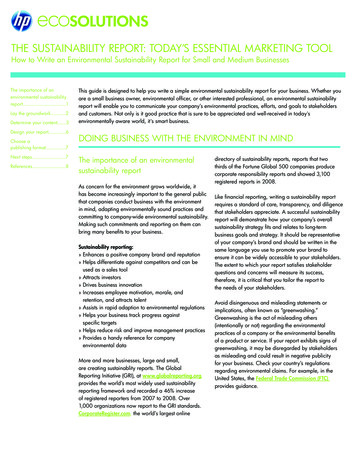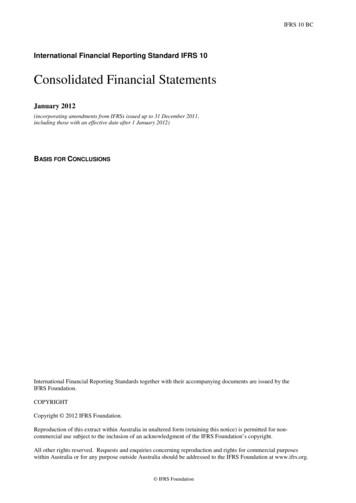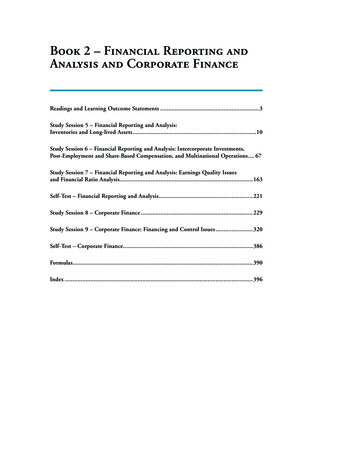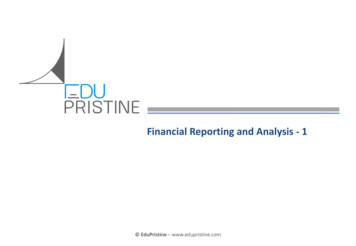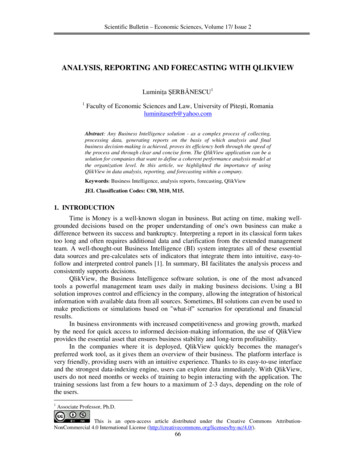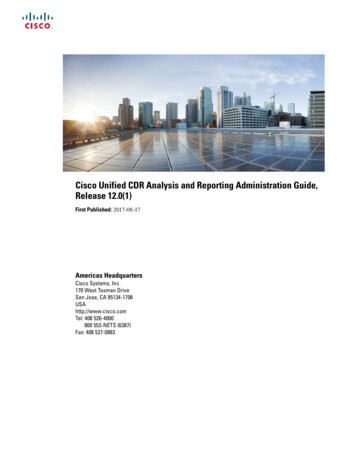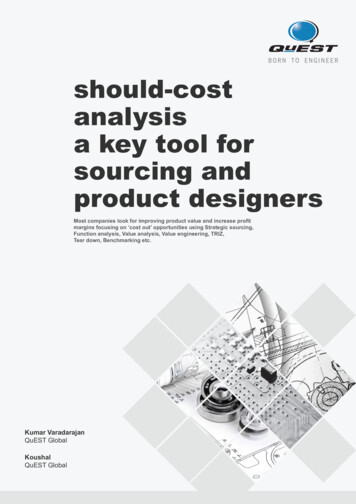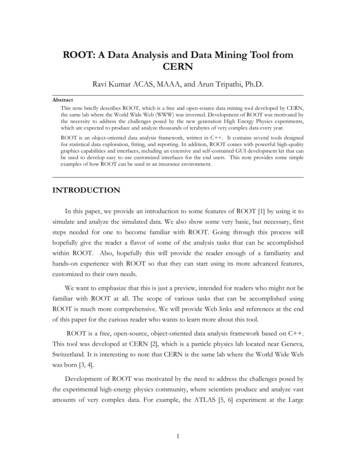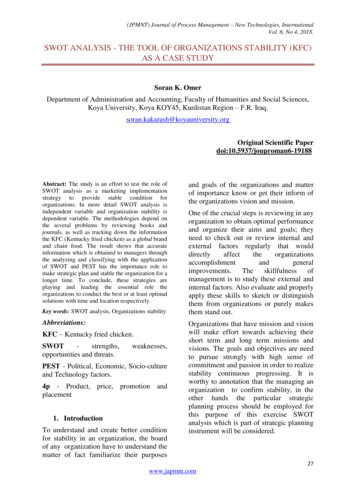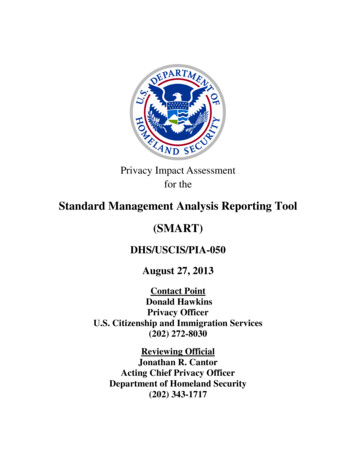
Transcription
Privacy Impact Assessmentfor theStandard Management Analysis Reporting Tool(SMART)DHS/USCIS/PIA-050August 27, 2013Contact PointDonald HawkinsPrivacy OfficerU.S. Citizenship and Immigration Services(202) 272-8030Reviewing OfficialJonathan R. CantorActing Chief Privacy OfficerDepartment of Homeland Security(202) 343-1717
Privacy Impact AssessmentUSCIS, SMARTPage 1AbstractThe Department of Homeland Security (DHS), United States Citizenship and ImmigrationServices (USCIS), Office of Information Technology (OIT) developed the Standard ManagementAnalysis Reporting Tool (SMART) to create and compile reports pertaining to immigrant andnonimmigrant benefits. SMART creates reports by temporarily retrieving information from USCISsource systems to create reports, which have either aggregate or individual data. USCIS is conductingthis Privacy Impact Assessment (PIA) to discuss the privacy risks and mitigations associated withreplicating and temporarily retaining personally identifiable information (PII) in SMART to createreports.OverviewThe Department of Homeland Security (DHS), United States Citizenship and ImmigrationServices (USCIS) collects, tracks, and stores large amounts of information related to administering andprocessing benefit requests for all immigrant and nonimmigrant benefits. The USCIS Office ofInformation Technology (OIT) developed the Standard Management Analysis Reporting Tool (SMART)to create and compile reports to track and monitor the status of immigrant and nonimmigrant benefitrequests and to assist USCIS in the decision-making process relating to immigration cases, case filelocations, and case metrics. SMART supports the USCIS mission by providing accurate and usefulinformation to USCIS employees responsible for managing the integrity of the immigration system.SMART, a subsystem of the enterprise Citizenship and Immigration Services Centralized OperationalRepository (eCISCOR), queries information from multiple USCIS systems, and creates and compilesreports pertaining to immigration benefits or cases, alien file tracking, and/or naturalization, in onecentralized location. Prior to SMART, in order to create reports, USCIS employees had to manuallyexport information from multiple USCIS systems, located in different physical locations and that useddifferent versions of database software. Employees had to separately access each system containinginformation necessary to complete the reports because the systems were unable to communicate with oneanother. After employees manually located the information, they would integrate it into a central location(e.g., Microsoft Excel spreadsheet or MS Access) to create a report.For example, a USCIS Headquarters (HQ) office is responsible for producing monthly reports inorder to identify files that are beginning to age. Prior to SMART, USCIS HQ created approximately 19reports a month for field offices using Microsoft Excel, to better identify, troubleshoot, and manage oldfile workflow. They would download approximately 90 files from the National File Tracking System(NFTS), which took the office roughly four hours to complete. USCIS HQ personnel then used MicrosoftExcel macros, a series of commands and functions, to consolidate the files by location in USCIS and thensort by the age of the file. Even using macros, the total process took about 15 hours each month. Theimplementation of SMART greatly alleviates this time consuming and labor intensive process.SMART allows the USCIS HQ office to create the reports on-demand with no manualintervention. HQ users can now create the same reports by accessing NFTS information through aSMART system interface. Once they create the reports, the field offices can access the reports within
Privacy Impact AssessmentUSCIS, SMARTPage 2SMART. SMART greatly reduces the amount of time spent on a report by allowing users to accessinformation and create reports in one centralized location.SMART Source SystemsSMART is an Oracle tool called Oracle Business Intelligence Enterprise Edition (OBIEE).SMART does not store any data. In order for SMART to be able to display the data to the end users via areport, SMART can obtain the data via two sources: eCISCOR Direct connection to the SMART source systemeCISCOR is a collection of databases that contains data from several USCIS systems. SMARTcan create reports using eCISCOR data or through a direct connection to multiple USCIS systems in orderfor users to create immigration reports without having to separately access each source system. Thesesystems, called the SMART source systems, store information that is generally collected directly fromindividuals applying for a USCIS benefit. SMART, which has a read-only interface with these sourcesystems, then temporarily retrieves the information to create and compile reports. Once the report iscreated and compiled, it is exported for further use by USCIS management. The data is not retainedwithin SMART.Although SMART communicates with these source systems, it only temporarily retrievesinformation. The temporary retrieval allows SMART to view the information in a read-only reportingformat. These reports help end users to obtain, view, and analyze the information both at the summarized,aggregate, or detailed level, in which personally identifiable information (PII) may be included,depending on the user’s needs.A complete list of the source systems that have a direct connection to SMART, are included inAppendix A of this PIA. USCIS will update Appendix A as OIT adds additional SMART-systeminterfaces.SMART ReportsWithin SMART, users can create either ad-hoc or use pre-defined reports to meet variousreporting needs at USCIS. If users create an ad-hoc report, they can choose the information fields ofinterest to be included in their reports, or can choose to aggregate the information in the reports. Predefined reports allow users to create reports with pre-set criteria. Since SMART does not retain anysource system information, a user opening a shared report re-queries the source system, which thenupdates the reports in real-time. Offices use SMART to create reports that assist with USCIS workloadmanagement. Offices cannot use SMART as a data mining tool to search across multiple systems to queryparticular individuals.Ad-hocAd-hoc reports allow users to build their own reports and specify data elements to be included.SMART users can create, organize, and share ad-hoc reports within SMART, but will only display theinformation from the source systems in a read-only format. For example, a user may access SMART to
Privacy Impact AssessmentUSCIS, SMARTPage 3create an ad-hoc report about employee misconduct that displays the number of allegations of employeemisconduct regarding a specific employee, and organize the report by allegation type.Pre-definedOffices may create pre-defined reports using specific criteria determined by business need, tasks,and user reporting requirements. SMART users cannot manipulate pre-defined reports to meet otherreporting needs. For example, the USCIS National Benefits Center (NBC) uses pre-defined reports tocompile certain case statistics, such as the number of adoption cases that USCIS receives each year. Thisreport displays the pending statuses (e.g., pending assignment, pending request for evidence) and theaverage case processing days.The use of ad-hoc or pre-defined reports varies on the user’s needs and/or the user’s type. Thereare three types of user groups for SMART:Standard user: Standard users have very limited privileges within SMART. Standard users haveread-only ability to run pre-defined reports that the Power user has created and saved. Standard usersmust use pre-determined criteria for their reports and cannot modify a report (i.e., they cannot add orremove fields defined in the report). However, these users can filter the information returned to thereport, if needed.Power user: Power users have the ability to create their own report dashboards, create ad-hocreports, and to save the ad-hoc report for others to use as pre-defined reports. Power users typically createone or more pre-defined reports for a group of Standard users to use on a daily, weekly, monthly, etc.basis.Administrator: The Administrator will have system privileges within SMART including accessto pre-defined and ad-hoc reports. Only the SMART Development Team and identified USCIS SMARTAdministrators will have administrator access.Below are examples of both ad-hoc and pre-defined reports that SMART can create, usingaggregated or source system information: The number of applications filed in a given period of time; The number of applications that were filed per benefit type; The number of applications are pending, approved, or denied, per benefit; The location of particular applications, including the A-Numbers associated with theapplications; The processing times for each application; The number of cases that exceeded the processing time; Specific immigration applications that have exceeded the designated processing times; The number of applications that were processed per hour;
Privacy Impact AssessmentUSCIS, SMARTPage 4 The average number of applications that were processed per hour (per division, team,and/or Officer); The number of forms associated with other forms prior to a particular date; and, The total number of forms by action status per regional center.The amount of information included in a report varies by the user’s business needs. Some usersneed elements of PII to be included in reports, while others do not. For example, some users create reportsin which the USCIS application receipt number or customers’ Alien number (A-number) must beincluded in the report (such as reports containing a customer’s applications history, application location,etc.). Other reports do not require PII in reports and can aggregate the information. SMART users havethe flexibility of tailoring the reports to fit their business needs.Once a user creates a report and logs out or disables SMART, it automatically deletes the sourcesystem information and is no longer accessible. If the user chooses to print or save the reports, he or shemay export and save the report in formats such as Microsoft Excel, Microsoft PowerPoint, Adobe PDF,and plain-text. USCIS departmental information management governance and security guidelines ensurethat employees are aware of the importance of safe keeping and destroying the reports when they are nolonger needed.SMART FunctionalitiesSMART organizes and displays USCIS source system information on pre-built standarddashboards and reports, helping users spend less time compiling reports and improve USCIS businessresults. SMART organizes dashboards by subject areas, such as source systems or offices. For example, ifa user is looking for a report about adoption, he or she views the Adoption dashboard.The first page, which displays after a user enters his or her credentials, is the My Dashboard page.This page is unique to each user account. SMART users are able to request the dashboards of their choicewhen submitting a SMART Access Request form. Dashboard access must be approved by the user’ssupervisor, and is granted to only users that have a need-to-know. Both the submitting user and the user’ssupervisor must agree the user has a need-to-know basis for accessing the requested source system’sinformation via SMART.After receiving access, if a user has a business need to create a report about adoption, he or shewould select the Adoption dashboard. Upon accessing the dashboard, users select the Report Index pagethat identifies the types of reports. The text on the Report Index page describes the reports a user canchoose to generate. For example, users can select the Adoption Application Page to create a report onadoption applications.Once a user chooses the relevant page (such as the Adoption Application Page), the dashboardprompts users to select optional information filters (i.e., Receipt Date Range, Country type, Adjudicator,or Decision). When a user does not make a selection, the report will display all information for the entirefilter. Each SMART dashboard is set up uniquely, but may include similar components. The user can thenselect the type of report he or she would like to create (e.g., Summary of Pending Application ProcessingReport, Summary of Completed Applications Report, and Summary of Request for Evidence (RFE)
Privacy Impact AssessmentUSCIS, SMARTPage 5Processing Report). The user can then select if he or she would like the report aggregated in a table orchart format. Once the user customizes the report, SMART generates and displays it.As mentioned above, once a user logs off, SMART deletes the report information. If users wouldlike to save the SMART reports, users can print or download the reports (in formats such as MicrosoftExcel, PowerPoint, and Adobe PDF) to assist users with various business purposes.Section 1.0 Authorities and Other Requirements1.1What specific legal authorities and/or agreements permit anddefine the collection of information by the project in question?USCIS’s legal authority for the collection and temporary retrieval ofinformation in SMART is theImmigration and Nationality Act, 8 U.S.C. § 1103.1.2What Privacy Act System of Records Notice(s) (SORN(s)) applyto the information?SMART uses information from the following SORNs: DHS/USCIS-001 - Alien File, Index, and National File Tracking System ofRecords, June 13, 2011, 76 FR 34233; DHS/USCIS-004 - Systematic Alien Verification for Entitlements Program, September21, 2011, 76 FR 58525; DHS/USCIS-005 - Inter-Country Adoptions Security, June 5, 2007, 72 FR 31086; DHS-USCIS-007 - Benefits Information System, September 29, 2008, 73 FR 56596; DHS/USCIS-010 - Asylum Information and Pre-Screening, August 8, 2012, 77 FR47419; DHS-USCIS-011 - E-Verify Program System of Records, May 9, 2011, 76 FR 26738; DHS/USCIS-013 - E-Verify Self Check, February 16, 2011, 76 FR 9034; DHS/ALL-004 - General Information Technology Access Account Records System(GITAARS), September 29, 2009, 74 FR 49882; and, DHS/ALL-020 - Department of Homeland Security Internal Affairs, November 18, 2008,73 FR 67529.
Privacy Impact AssessmentUSCIS, SMARTPage 61.3Has a system security plan been completed for the informationsystem(s) supporting the project?A system security plan (SSP) for SMART is complete. SMART is a sub-system to eCISCOR,and therefore operates under the eCISCOR authority to operate (ATO). eCISCOR’s ATO was grantedDecember 19, 2012, for a period of 18 months. The eCISCOR ATO expires on June 19, 2014. TheeCISCOR Security Plan was completed on September 18, 2012.1.4Does a records retention schedule approved by the NationalArchives and Records Administration (NARA) exist?SMART displays read-only information from existing systems for reporting purposes. The usersretain reports for business purposes and then destroy them when no longer needed in accordance withNARA’s General Record Schedule 20, Item 16.1.5If the information is covered by the Paperwork Reduction Act(PRA), provide the OMB Control number and the agency numberfor the collection. If there are multiple forms, include a list in anappendix.SMART is not subject to PRA requirements because it receives information from various sourcesystems that are responsible for their own compliance with the PRA.Section 2.0 Characterization of the InformationThe following questions are intended to define the scope of the information requested and/or collected, aswell as reasons for its collection.2.1Identify the information the project collects, uses, disseminates, ormaintains.SMART retrieves and displays information from each source system based on the query.Appendix B provides a detailed list of data elements that can be displayed via SMART from theconnected source systems. This information may include, but is not limited to: the applicant's name,Social Security Number (SSN), gender, date of birth, residence address, phone number, e-mail address,certificate of citizenship number, naturalization certificate number, A-number, and name of employeeprocessing the file. SMART does not maintain any of the information generated during a query anddisplays information in a read-only format.2.2What are the sources of the information and how is theinformation collected for the project?SMART does not collect information directly from the individual. It retrieves read-onlyinformation from various USCIS source systems. Most of the information in the source systems is
Privacy Impact AssessmentUSCIS, SMARTPage 7collected directly from the individual and is transferred from the source system to SMART in real-time.A complete list of the systems that provide information to SMART is in Appendix A.USCIS may add SMART source systems in the future to allow users to create additional reports.If this occurs, USCIS will update the PIA appendices to discuss the privacy implications of the additionalsource system.2.3Does the project use information from commercial sources orpublicly available data? If so, explain why and how thisinformation is used.SMART does not collect, use, or maintain commercial or publicly available information, asdescribed in this PIA. However, some of the SMART source systems may collect, use and/or maintaincommercial sources or publicly available information.2.4Discuss how accuracy of the data is ensured.SMART assumes the information it generates from source systems is accurate. SMART queriessource systems in real-time to ensure the information is current and up-to-date. SMART is not the originalpoint of collection for the information generated in the reports it provides to its users. The accuracy ofSMART reports is dependent on the accuracy of source system information. If the user questions theaccuracy of the information, he or she should refer to the source system or data owner for validity.2.5Privacy Impact Analysis: Related to Characterization of theInformationPrivacy Risk: In developing SMART, there was a risk that SMART could copy and retain allingested data.Mitigation: This risk was mitigated because SMART was not designed to collect or store anyinformation. Instead, SMART temporarily retrieves information from the SMART source systems tocreate reports. Once SMART generates the report, and the user signs out, SMART deletes theinformation.Section 3.0 Uses of the InformationThe following questions require a clear description of the project’s use of information.3.1Describe how and why the project uses the information.USCIS collects, tracks, and stores large amounts of information related to administering andprocessing applications for all immigrant and nonimmigrant benefits. SMART specifically uses theinformation to create and compile reports to assist in the workload management decision-making processrelating to immigration cases, case file locations, and case metrics.
Privacy Impact AssessmentUSCIS, SMARTPage 8SMART queries the source systems to compile reports that provide USCIS with a better view andunderstanding of USCIS information. The type of information queried varies based on the type of reports.SMART helps end users to obtain, view, and analyze the information in report formats.3.2Does the project use technology to conduct electronic searches,queries, or analyses in an electronic database to discover or locatea predictive pattern or an anomaly? If so, state how DHS plans touse such results.SMART is a reporting application that USCIS uses to organize and model information to helpend users to obtain, view, and analyze the information in report formats. Although it is not the primaryfunction of the tool, when the data is displayed in a report format, users may be able to discoveranomalies and patterns in sources systems and to work with the specific source system to correct it.SMART reports are generated to assist with USCIS workload management and are not used as datamining tools to search across multiple systems
Aug 27, 2013 · Analysis Reporting Tool (SMART) to create and compile reports pertaining to immigrant and nonimmigrant benefits. SMART creates reports by temporarily retrieving information from USCIS source systems to create reports, which have either aggregate or individua USCIS is conducting l data.File Size: 230KB

